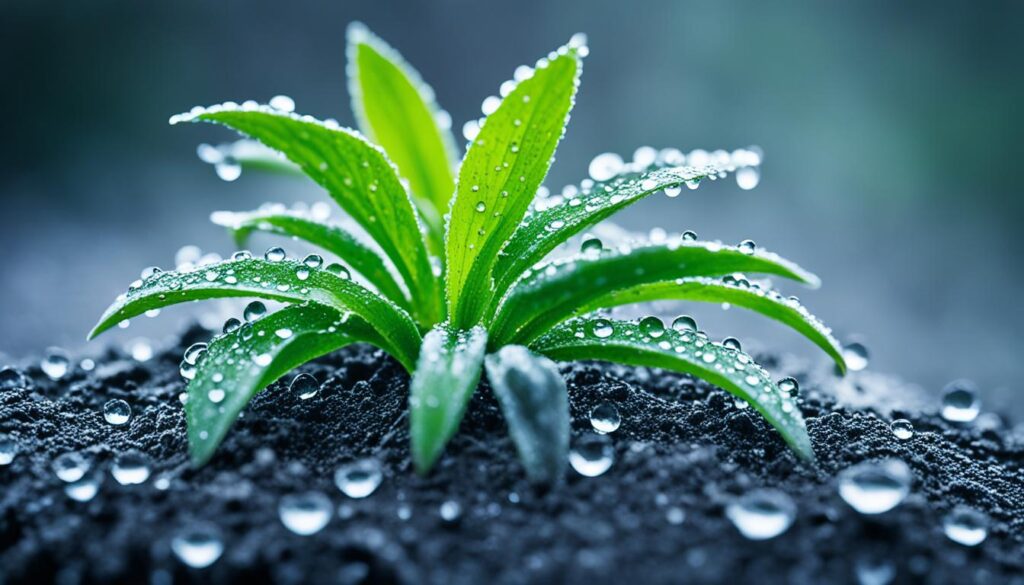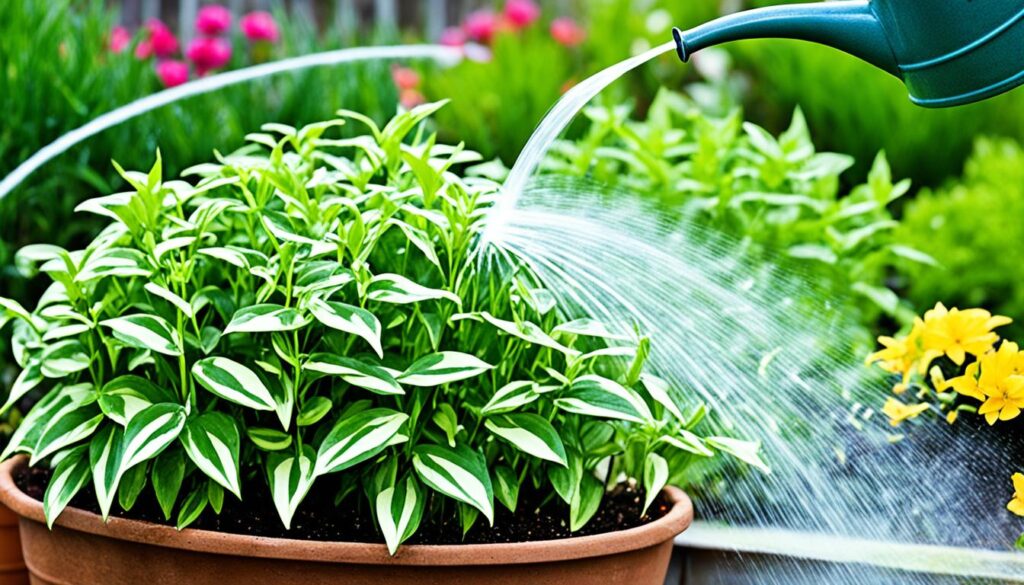Are your plants not doing well, both inside and outside? Don’t worry. We’ve got the advice you need to make your garden look amazing. This detailed guide will teach you everything. From picking the right sunlight requirements to learning how to water and keep pests away. It’s perfect for everyone, whether you’re new to plants or you’ve been gardening for a while.
First things first, let’s answer a big question: What’s the secret to keeping your plants happy and healthy? We’ll explore the answer so you can make your plants thrive.
Choose the Right Light for Your Plants
Adequate sunlight is essential for plant health. The amount of light needed varies by type. Knowing your plants’ sunlight needs is key to their success.
Bright Light Requirements
Plants needing bright light must get 6 hours of direct sun daily. Succulents, cacti, and some tropical plants love sunny spots. They do best in south-facing windows or bright places.
Medium Light Requirements
Medium light plants need 3-6 hours of sunlight that’s not direct. These include Chinese evergreen and pothos. They can handle some shade but not low-light spots.
Low Light Requirements
Low light plants do well with just 1-3 hours of light daily. Plants like snake plants and peace lilies can live where it’s dim. They’re perfect for spaces with little natural light.
Knowing your plants’ light needs helps you place them right. By choosing the best spots in your home, your bright light plants, medium light plants, and low light plants will all do great.
Water Your Plants Properly
Keeping your plants healthy means learning how to water them right. It’s key to know how wet the soil is and use good watering methods. This helps avoid too much or too little water, which can harm your plants.
Checking Soil Moisture Levels
Start by checking if the soil is moist enough. Gently poke your finger into the soil or use a moisture meter for a precise check. The soil should be slightly damp, but not soggy.
Watering Techniques
Water your plants by pouring it slowly at the base. Be careful not to wet the leaves and stems, as this can cause fungus. Make sure your plant’s watering needs match the season and where they live.
Learning to water your plants correctly is vital for their health and growth.

Maintain Ideal Humidity Levels
Keeping the right plant humidity requirements is vital for many houseplants. Especially those from tropical places. They’re used to lots of moisture and need it to do well inside. Keep the humidity between 40-50% for the best plant health.
To up the humidity for houseplants, try a few things. Put your plants near each other to make a mini-moist area. You can also fill a tray with pebbles, mist the leaves, or get a humidifier. All these help add more moisture to the air.
| Humidity Level | Plant Preference |
|---|---|
| 40-50% | Ideal for most houseplants, including tropical varieties |
| 30-40% | Suitable for succulents and cacti, which prefer drier conditions |
| 50-60% | Ideal for humidity-loving plants like ferns, orchids, and certain palms |
By getting the humidity levels for indoor plants just right, you make a great place for them to grow. Watch the humidity and adjust as needed. This will keep your plants in top shape.

plant care tips
To keep your plants happy, you need to understand the best plant watering schedule for them. Knowing when and how much to water is key. Too much water is as bad as too little. So, watch out for the signs of over or under watering your plants.
Watering Schedules and Amounts
The right plant watering schedule varies. It depends on what kind of plant you have, the size of its pot, the soil, and your climate. A good rule is to let the top layer of soil dry before watering again.
When you do water, make sure to do it deeply. The water should flow out from the bottom of the pot.
Signs of Overwatering and Underwatering
Knowing the signs of overwatering and underwatering is important. Overwatered plants might have yellow leaves, soft stems, or even mold. Plants that need more water may look droopy, have dry leaves, and not grow well. Watch your plants’ looks. It tells you what to do to keep them healthy.

Fertilize for Optimal Growth
Proper fertilization is key for your plants’ health and vibrant growth. It’s important to know the different plant fertilizers out there and have a good fertilizing schedule. This can help your plants achieve their best.
Types of Fertilizers
There are many types of plant fertilizers to choose from. Organic ones, like compost, slowly release essential nutrients and better soil. Synthetic fertilizers work quickly but should be used carefully to prevent over-fertilization.
Fertilizing Schedules
Finding the right fertilizing schedule for your plants is important. How often and how much you fertilize depends on the plant, its growth stage, and soil needs. For most plants, a balanced fertilizer every 4-6 weeks in the growing season is good.
Avoiding Over-Fertilization
Using plant fertilizers is vital, but too much can harm your plants. Too many nutrients can cause salts to build up in the soil and harm the plant. Always follow the fertilizer’s instructions. Watch for signs of over-fertilization, like wilting or stunted growth.

Propagate and Divide Plants
Propagating and dividing your plants is a wonderful way to grow your collection or refresh old plants. You can do this to make more of your favorites or to help a crowded pot. These plant propagation and plant division methods will guide you.
Propagation Methods
There are many propagation methods to copy plants from the ones you have. Some common ones are:
- Stem cuttings: Snip a 4-6 inch piece from a healthy stem, take off the lower leaves, and root it in water or soil.
- Leaf cuttings: Pick a good leaf, with a bit of its stem, and place it in water or soil to grow a new plant.
- Division: Dig up a plant and split its roots, making sure each new part has good roots and green parts.
- Offsets: Snip off and plant new little plants growing at the parent plant’s base.
Dividing Techniques
Dividing plants refreshes crowded pots and lets you give plants to others. Most plants like to be divided in the spring or fall. This is when they are growing. Here’s what you do:
- Take out the plant carefully from its pot or ground, trying not to harm its roots.
- With a sharp tool, split the roots into pieces, making sure each piece has roots and leaves.
- Plant these parts in good soil and give them a good soak.
- Watch over these new plants and give them a bit more care until they are doing well.
Learning these propagation methods and dividing techniques lets you grow your plant collection and teach others. Try out different ways to find what’s best for your favorite plants.
Repot and Refresh Soil
As plants grow, their roots may get crowded in the pot. This means it’s time to repot. Watch for signs like roots coming out of the bottom or the soil drying fast. When you repot, pick a pot just a bit bigger, about 2-3 inches wider. This gives the roots space to grow.
Signs of Root-Boundedness
How can you tell if a plant needs a new pot? Look for these clues:
- Roots growing out of the drainage holes
- Soil drying out quickly, even with regular watering
- Stunted growth or yellowing leaves
- The plant becoming top-heavy and unstable in the pot
Proper Pot Sizing
When it’s time to repot, choose a new pot just a bit larger. A too-big pot can cause trouble, like too much water around the roots. Aim for 2-3 inches of extra space around the root ball. This makes sure there’s enough room for roots to grow but not get crowded. Don’t forget to refresh the soil too, since old soil can lose its nutrients.
| Plant Size | Pot Diameter |
|---|---|
| Small plants (6-8 inches tall) | 4-6 inches |
| Medium plants (12-18 inches tall) | 6-8 inches |
| Large plants (24 inches or taller) | 8-12 inches |
By keeping an eye on your plants and their pot size, you help them stay healthy. When they outgrow their pots, it’s time to move them. This keeps your plants thriving for a long time.
Prune and Groom Plants
Regular pruning and grooming keep your plants at their best. It makes them grow healthy and look lively. When you remove dead or damaged plant parts, the plant focuses its energy on new, beautiful growth.
Pruning Techniques
Cutting plants right depends on the type. Always use clean, sharp shears. Cut above a bud or leaf pointing out. This makes the plant grow nice and stop from getting hurt. Angle your cuts a bit to keep the water off and avoid rot.
Removing Dead or Damaged Parts
Check your plants often. Take away any dead, damaged, or diseased parts to keep them healthy. Cut off leaves or stems that are yellow, brown, or droopy. Be careful not to hurt the good part of the plant. Throw away what you cut to stop bugs or diseases from spreading.
With these pruning and grooming tips, your plants, both inside and outside, will look amazing. They will grow strong and colorful for many seasons.
Pest and Disease Management
Keeping your plants healthy is about more than just the right conditions. Pests and diseases are big threats to your plants, inside and outside. It’s important to know the common houseplant pests and plant diseases. Also, learning about the best treatment methods will help you keep your plants in great shape.
Common Houseplant Pests
Among the most common houseplant pests are spider mites, mealybugs, aphids, scale insects, and thrips. They can harm your plants by damaging leaves, stems, and roots. Checking your plants often is key. Look for signs like webbing, sticky stuff, or tiny bugs to stop problems early on.
Treating Pests and Diseases
When dealing with treating plant pests and diseases, try several methods. You might use natural pest control like adding helpful bugs, or using oils and soaps. For more serious problems, you might need chemicals. If you go this route, always use these products according to the instructions.
Keeping an eye on your plants and acting quickly is crucial. By watching closely and solving problems fast, you can keep your plants and gardens healthy and beautiful.
Sourcing Healthy Plants
Buying healthy plants from trusted places is vital for their future. Look for vibrant, healthy growth. Avoid those that seem stressed or diseased. The best places to buy from are nurseries, garden centers, and online stores known for their quality plants.
Focus on the look of the leaves, stems, and roots when picking out plants. Good plants have clean leaves, strong stems, and developed roots. Stay away from plants with damaged leaves, bad stems, or rotting roots. These issues can harm the plant and make it hard to revive.
It’s smart to know your local plant sellers. They can help you choose the right plants and teach you how to care for them. By doing a bit of research and being observant, you can make sure your new plants will be strong and ready to grow in your garden.



